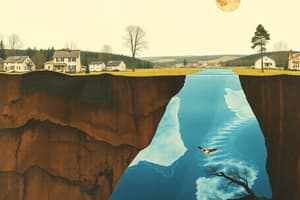Podcast
Questions and Answers
What is an artesian well?
What is an artesian well?
- A well that is always dry.
- A well that can spurt water above the land surface. (correct)
- A well drilled into a non-pressurized aquifer.
- A well that requires a pump to extract water.
In the experimental setup, where would you expect the water level to be highest?
In the experimental setup, where would you expect the water level to be highest?
- At the high end of the container. (correct)
- At the low end of the container.
- At the middle of the container.
- Throughout the container at the same level.
Where is the water likely to be under the greatest pressure in the experimental setup?
Where is the water likely to be under the greatest pressure in the experimental setup?
- Near the top of the sand layer.
- At the low end of the container. (correct)
- In the impermeable layer of clay.
- At the exact middle of the container.
What will most likely happen if water flows from one of the straws in the experiment?
What will most likely happen if water flows from one of the straws in the experiment?
What material is used to cover the sand in the experiment to prevent water flow?
What material is used to cover the sand in the experiment to prevent water flow?
What percentage of freshwater on Earth is stored in polar ice caps and glaciers?
What percentage of freshwater on Earth is stored in polar ice caps and glaciers?
What is the process called when precipitation infiltrates the ground and becomes groundwater?
What is the process called when precipitation infiltrates the ground and becomes groundwater?
How does porosity affect groundwater storage?
How does porosity affect groundwater storage?
Which component is NOT directly involved in the cycling of groundwater?
Which component is NOT directly involved in the cycling of groundwater?
What primarily composes the hydrosphere on Earth?
What primarily composes the hydrosphere on Earth?
What describes the small openings in sediment and rock that store groundwater?
What describes the small openings in sediment and rock that store groundwater?
Which of the following best explains the relation between aquifers and springs?
Which of the following best explains the relation between aquifers and springs?
How does the size and variety of particles in a material influence porosity?
How does the size and variety of particles in a material influence porosity?
What is the region below the Earth's surface where all pores are filled with groundwater called?
What is the region below the Earth's surface where all pores are filled with groundwater called?
What occupies the pores in the zone of aeration?
What occupies the pores in the zone of aeration?
How is gravitational water primarily moved?
How is gravitational water primarily moved?
What defines the upper boundary of the zone of saturation?
What defines the upper boundary of the zone of saturation?
What type of water is held in pore spaces above the water table due to surface tension?
What type of water is held in pore spaces above the water table due to surface tension?
Which characteristic typically does NOT describe the zone of saturation?
Which characteristic typically does NOT describe the zone of saturation?
What causes variability in the depth of the water table?
What causes variability in the depth of the water table?
Which of the following best describes the interaction between gravitational and capillary water?
Which of the following best describes the interaction between gravitational and capillary water?
What is the term for a layer of permeable subsurface material that is saturated with water?
What is the term for a layer of permeable subsurface material that is saturated with water?
What does the permeability of a material refer to?
What does the permeability of a material refer to?
Which of the following describes barriers to groundwater flow?
Which of the following describes barriers to groundwater flow?
What factors influence the flow velocity of groundwater?
What factors influence the flow velocity of groundwater?
What are natural discharges of groundwater at Earth’s surface known as?
What are natural discharges of groundwater at Earth’s surface known as?
Where can springs emerge from?
Where can springs emerge from?
How does the water table fluctuate?
How does the water table fluctuate?
Which of the following statements is true about the emergence of springs?
Which of the following statements is true about the emergence of springs?
What characterizes hot springs compared to regular springs?
What characterizes hot springs compared to regular springs?
What phenomenon occurs when a geyser erupts?
What phenomenon occurs when a geyser erupts?
What occurs as a result of overpumping from wells?
What occurs as a result of overpumping from wells?
What defines an artesian aquifer?
What defines an artesian aquifer?
How does the temperature of water discharged from a spring typically compare to the ambient temperature?
How does the temperature of water discharged from a spring typically compare to the ambient temperature?
What is the main cause of a cone of depression around a well?
What is the main cause of a cone of depression around a well?
What is the primary purpose of a well?
What is the primary purpose of a well?
What happens to the temperature of water in warm springs compared to springs in cooler climates?
What happens to the temperature of water in warm springs compared to springs in cooler climates?
Flashcards
Groundwater storage
Groundwater storage
Groundwater is stored in the pore spaces of materials like soil, sediment, and rock beneath Earth's surface.
Porosity
Porosity
The amount of pore space in a material, determined by the size and type of particles.
Infiltration
Infiltration
Precipitation soaking into the ground to become groundwater.
Groundwater
Groundwater
Signup and view all the flashcards
Water Cycle
Water Cycle
Signup and view all the flashcards
Precipitation
Precipitation
Signup and view all the flashcards
Aquifer
Aquifer
Signup and view all the flashcards
Spring
Spring
Signup and view all the flashcards
Zone of Saturation
Zone of Saturation
Signup and view all the flashcards
Zone of Aeration
Zone of Aeration
Signup and view all the flashcards
Gravitational water
Gravitational water
Signup and view all the flashcards
Capillary water
Capillary water
Signup and view all the flashcards
Water movement
Water movement
Signup and view all the flashcards
Varying water table
Varying water table
Signup and view all the flashcards
Unsaturated Zone
Unsaturated Zone
Signup and view all the flashcards
Permeability
Permeability
Signup and view all the flashcards
Aquiclude
Aquiclude
Signup and view all the flashcards
Groundwater flow velocity
Groundwater flow velocity
Signup and view all the flashcards
Spring (groundwater)
Spring (groundwater)
Signup and view all the flashcards
Groundwater discharge
Groundwater discharge
Signup and view all the flashcards
Spring emergence locations
Spring emergence locations
Signup and view all the flashcards
Spring Temperature
Spring Temperature
Signup and view all the flashcards
Warm Springs
Warm Springs
Signup and view all the flashcards
Hot Springs
Hot Springs
Signup and view all the flashcards
Geysers
Geysers
Signup and view all the flashcards
Well
Well
Signup and view all the flashcards
Ordinary Well
Ordinary Well
Signup and view all the flashcards
Overpumping
Overpumping
Signup and view all the flashcards
Artesian Well
Artesian Well
Signup and view all the flashcards
Artesian aquifer
Artesian aquifer
Signup and view all the flashcards
What is an artesian well?
What is an artesian well?
Signup and view all the flashcards
What makes water rise in an artesian well?
What makes water rise in an artesian well?
Signup and view all the flashcards
How would the water table in the container change if water flowed from one of the straws?
How would the water table in the container change if water flowed from one of the straws?
Signup and view all the flashcards
Study Notes
Groundwater Storage and Movement
- Groundwater is stored in pore spaces within soil, sediment, and rock.
- Porosity is the amount of pore space in a material and is influenced by particle size and variety.
- The zone of saturation is where groundwater completely fills the pores.
- The water table is the upper boundary of the zone of saturation.
- A perched water table lies above the main water table due to an impermeable layer.
Groundwater Movement
- Flow velocity depends on the slope of the water table and permeability of the material.
- Permeability is the ability of a material to allow water to pass through it.
Springs
- Springs are natural discharges where groundwater emerges at Earth's surface.
- Springs can emerge from various locations like sides of valleys, fault lines, or underground pathways.
- Spring temperature is generally the average annual temperature of the region.
- Warm or hot springs have temperatures higher than the average annual temperature.
- Geysers are explosive hot springs in which heated water vapor builds up tremendous pressure before erupting.
Wells
- Wells are dug or drilled into the ground to reach aquifers.
- Ordinary wells are dug or drilled into the water table. Overpumping can cause a cone of depression in the water table.
- Artesian wells tap into pressurized aquifers and can cause the water to rise above the land surface.
Studying That Suits You
Use AI to generate personalized quizzes and flashcards to suit your learning preferences.




